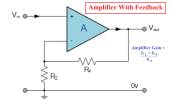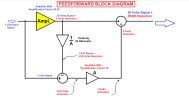I am going to try and Explain Negative Feedback & Feedforward without complex math. Lets start with Negative Feedback.
NEGATIVE FEEDBACK
It enables even an idiot of a circuit designer to create an amplifier with Immaculate specifications !
 View attachment 66459
View attachment 66459
Above is a block diagram of aa amplifier using Negative Feedback.
The Blue triangle represents an amplifier. Its a Shabby designed amplifier with lots and lots of gain (eg Gain of 1 million) , but very high distortion (like 30% to 50%), High Noise, and very low bandwidth (like a frequency response of 1 Hz, yup TAT Bad).
Vin is the input voltage & Vout is the Output voltage
The Output Voltage is divided / reduced / attenuated by 2 resistors Rf & R2.
The attenuated Output voltage (Junction of Rf & R2 is fed back to an input of the amplifier and subtracted from the input. Since the feedback signal is Subtracted from the input signal, it is called Negative feedback.
The amplifier's gain without negative feedback is called its "Open Loop Gain"
With this simple routing of signal, something MIRACULOUS happens.
The (Closed Loop) gain of the circuit above is determined by Rf & R2 and can be set at anything from a gain of 1 (Unity Gain) to the open loop gain of the amplifier, if Rf is made infinite (ie removed)
Lets say the new circuit has a Closed loop Gain of 10. ie reduced from 1 million to 10 or reduced by a factor of 100,000.
The miraculous result of Negative Feedback is that the new circuit has:
- Gain of 10 (instead of 1 million)
- Distortion & Noise reduced by a factor of 100,000 so 50% distortion will be reduced to 0.0005% distortion.
- Frequency response will improve from 1 Hz to 1,00,000 Hz ie 100 KHz !
Clearly all that a circuit designer using negative feedback needs to do, is design a shabby amplifier with lots and lots of gain.
Why Is Negative Feedback Bad ?
Look closely at the block diagram above.... The Signal has already reached the output, and the feedback is taken from the output and a loop created. If the signal is a very fast signal, it may be too late for the feedback to take effect and correct the output! Then, for a Very Brief moment, you will have the performance of the VERY Shoddy Open loop amplifier, with 50% distortion, etc
That is why Modern designs prefer to have a good performance open loop amplifier to beginb with, and just optimise its performance with a modest amount of feedback.
NOTE: Feedback will reduce distortion by a multiple, eg 10 time or 100 times or even 1000 times lower, but will can never make the distortion ZERO. To make the distortion ZERO, you need feedforward.
FEEDFORWARD
Feedforward is a completely different technique that Cancels the distortion generated by the amplifier. This is shown in the figure below:
View attachment 66460
To make the explanation easy, I have taken a 1 Volt input signal and the amplifier with a gain of 20.
I have also assumed a nasty amout of distortion: 3 Volts.
The amp output signal is fed to an attenuator or a divider, that can be simply 2 resistors.,. The attenuation is 20 ie the same as the amplifier gain. This brings the signal level back to that of the input., leaving a signal equal to the input but with the extra bit ..... the amplifier's distortion.
The Original signal is subtracted from it, leaving only the distortion, which is amplified by the second amplifier.
Finally the distortion is subtracted from the distorted amplified signal, leaving only the Amplified signal with Zero Distortion!
Again, the feedforward scheme relies on the entire signal routing being fast enough to be in time to cancel the distortion at the output. If that does not happen, you will again hear nasty sound.
Halcro amps used Feedforward to reduce distortion to vanishingly low amounts... It does not mean their circuits were perfect, thgey just used "Jugglery" to cancel the generated distortion...

Incidentally, Both Feedback & Feedforward were invented by the same person ....Harold Stephen Black (1898 to 1983)
He invented Feedforward in 1924 BEFORE he invented feedback in 1927.



